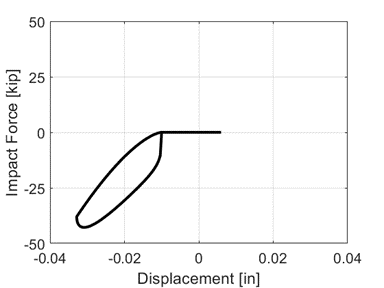3.1.5.31. Jankowski Impact Material
This command is used to construct the uniaxial Jankowski Impact Material
- uniaxialMaterial JankowskiImpact $matTag $Kh $xi $Meff $gap <$n>
Argument |
Type |
Description |
|---|---|---|
$matTag |
integer |
integer tag identifying material. |
$Kh |
float |
nonlinear Hertz contact stiffness. |
$xi |
float |
impact damping ratio. |
$Meff |
float |
effective mass. |
$gap |
float |
initial gap |
$n |
float |
indentation exponent (optional with default value of 1.5). |
Note
This material is implemented as a compression-only gap material, so $gap should be input as a negative value.
This material model follows the constitutive law
\[\begin{split}f_c(t) = \left\{ \begin{array}{ }k_h (\delta(t)-g)^n + c_J(t) \dot{\delta}(t) & \quad \dot{\delta}(t) > 0 \\ k_h (\delta(t)-g)^n & \quad {\dot{\delta(t)} \leq 0} \end{array}\right.\end{split}\]
where t is time, \(f_c (t)\) is the contact force, \(k_h\) is the nonlinear Hertz contact stiffness ($Kh), \(\delta(t)\) is the indentation, g is the initial gap ($gap), n is the indentation exponent ($n), and \(\dot{\delta}(t)\) is the indentation velocity. Damping is only applied during the approach phase, when \(\delta (t) > 0\). The damping coefficient \(c_J`\) is computed as
\[c_h = 2 \xi_j \sqrt{ m_{\textrm{eff}} k_h (\delta(t) -g)^{n-1}}\]
where \(m_{\textrm{eff}}\) is the effective mass of the system ($Meff), computed using the masses of the coliding bodies \(m_1\) and \(m_2\):
\[m_{\textrm{eff}} = \frac{m_1 m_2}{m_1 + m_2}\]
The damping ratio \(\xi_j\) ($xi) is usually related to the coefficient of restitution, represented by e. The recommended form of \(\xi_j\) is
\[\xi = \frac{9\sqrt{5}}{2} (\frac{1-e^2}{e(e(9\pi-16)+16)})\]
Response of the JankowskiImpact material during impact:
Note that the flat displacement from 0 to roughly minus 0.01 inch displacement is caused by the gap parameter.
Code Developed by: Patrick J. Hughes, UC San Diego
Non-linear viscoelastic modelling of earthquake-induced structural pounding. Earthquake Engineering and Structural Dynamics 2005; 34(6): 595–611. DOI: 10.1002/eqe.434.
Analytical expression between the impact damping ratio and the coefficient of restitution in the non-linear viscoelastic model of structural pounding. Earthquake Engineering and Structural Dynamics 2006; 35(4): 517–524. DOI: 10.1002/eqe.537.
Jankowski R. Theoretical and experimental assessment of parameters for the non-linear viscoelastic model of structural pounding. Journal of Theoretical and Applied Mechanics (Poland) 2007.
Hughes PJ, Mosqueda G. Evaluation of uniaxial contact models for moat wall pounding simulations. Earthquake Engineering and Structural Dynamics 2020(March): 12–14. DOI: 10.1002/eqe.3285.
